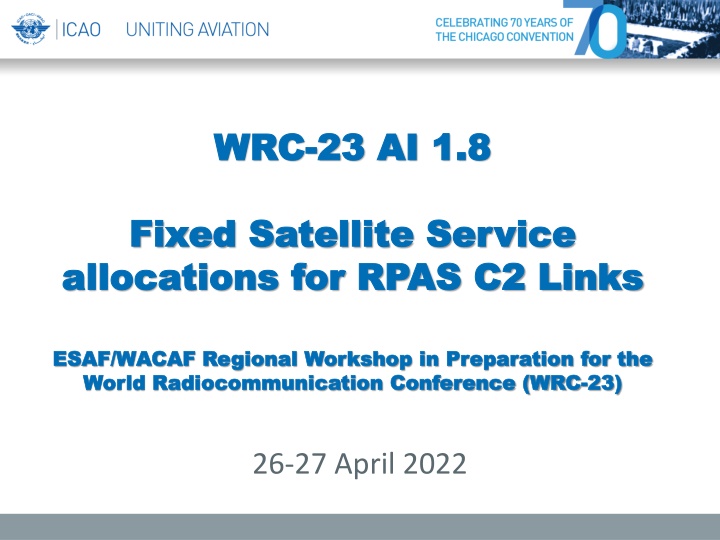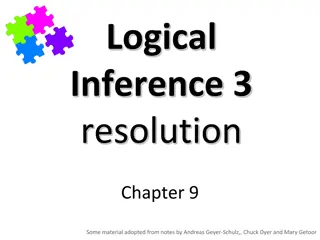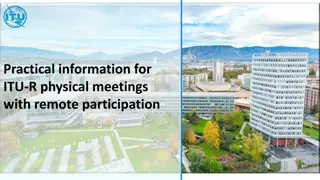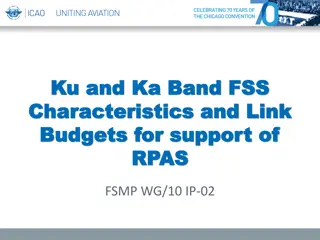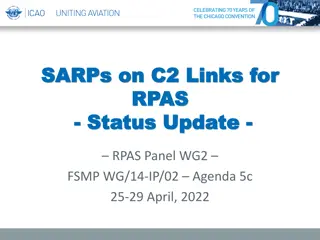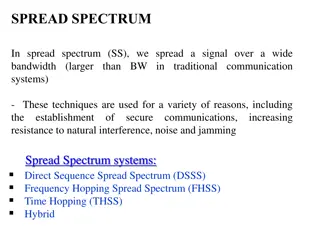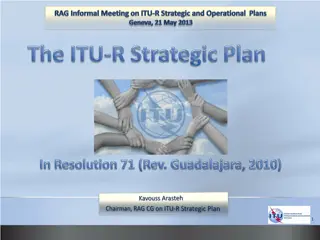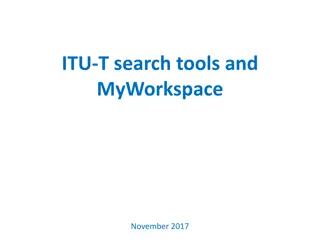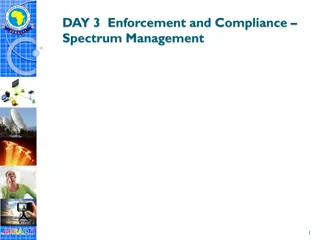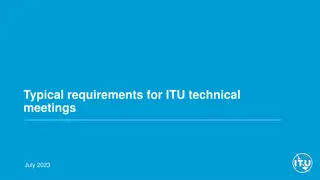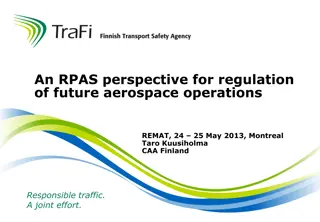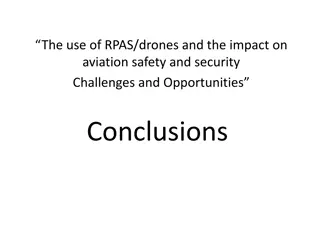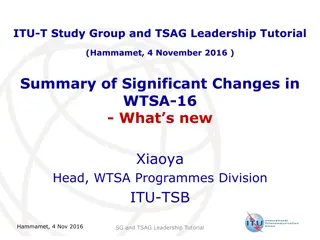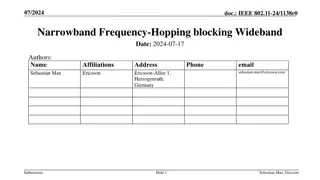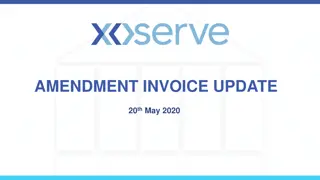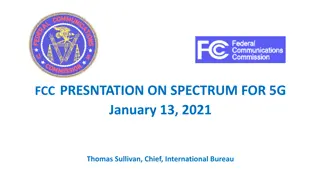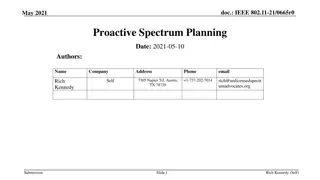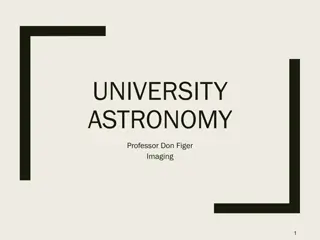Spectrum Allocations for RPAS C2 Links and ITU-R Resolution 155 Status Update
This content delves into the spectrum allocations for RPAS C2 links to facilitate safe operation in non-segregated airspace, covering the background, regulatory considerations, technical aspects, and updates from ITU-R Resolution 155. It highlights the identified frequency allocations for different bands and discusses the historical progression towards accommodating unmanned aircraft systems. The briefing also outlines the responsibilities of relevant entities like ICAO and the anticipated changes leading up to WRC-23.
Download Presentation

Please find below an Image/Link to download the presentation.
The content on the website is provided AS IS for your information and personal use only. It may not be sold, licensed, or shared on other websites without obtaining consent from the author.If you encounter any issues during the download, it is possible that the publisher has removed the file from their server.
You are allowed to download the files provided on this website for personal or commercial use, subject to the condition that they are used lawfully. All files are the property of their respective owners.
The content on the website is provided AS IS for your information and personal use only. It may not be sold, licensed, or shared on other websites without obtaining consent from the author.
E N D
Presentation Transcript
WRC WRC- -23 AI 1.8 23 AI 1.8 Fixed Satellite Service Fixed Satellite Service allocations for RPAS C2 Links allocations for RPAS C2 Links ESAF/WACAF Regional Workshop in ESAF/WACAF Regional Workshop in Preparation for the World Radiocommunication Conference (WRC World Radiocommunication Conference (WRC- -23) Preparation for the 23) 26-27 April 2022
AI-1.8 and ITU-R Resolution 155 Status Update Background Brief history Identified frequency allocations ICAO responsibilities Regulatory considerations Principals e.g., operate as a typical FSS Earth station Notification and coordination Identifying responsibilities Techncial considerations RPA/UA Earth station characteristics Protecting incumbent services pfd mask Link Budgets Resolution 155 WRC-19 overview Anticipated changes to Resolution 155 for WRC-23 ICAO Position and WRC-23 desired outcome 2
Brief History Report ITU-R M.2171, 12/2009 = Characteristics of unmanned aircraft systems and spectrum requirements to support their safe operation in non segregated airspace Identified the need for at least 56MHz (and possibly 198MHz) of spectrum for the projected number of UAS/RPAS anticipated to be operating in the 2030 timeframe In 2009 only L Band AMS(R)S systems existed but with an inadequate spectrum capacity A coprimary AM(R)S and AMS(R)S allocation exists at 5030-5091MHz but to date no satellite systems are operating and some of the band would need to be set aside for AM(R)S Already operating Ku and Ka Band FSS systems were identified as a potential solution, but they are not AMS(R)S Resolution 155, WRC-2015 Regulatory provisions related to earth stations on board unmanned aircraft which operate with geostationary-satellite networks in the fixed-satellite service in certain frequency bands not subject to a Plan of Appendices 30, 30A and 30B for the control and non-payload communications of unmanned aircraft systems in non-segregated airspaces Resolution 155, WRC-2019 Minor update to recognize a second pfd mask to protect terrestrial services based on work carried out during the 2015-2019 study cycle 3
Identified Frequency Allocations Ku space-to-Earth = 10.95-12.75GHz (region dependent) Ku Earth-to-space = 14-14.47GHz Ka space-to-Earth = 19.7-20.2GHz Ka Earth-to-space = 29.5-30GHz FSS C Band (3-4GHz/5-6GHz) not considered because of the limited antenna size on the RPA/UA not providing sufficient link margin 4
ICAO Responsibilities ICAO SARPs, covering all C2 Link technologies, are being developed within the RPAS Panel New Volume VI, in Annex 10, for C2 Link SARPs Part I (Procedures) adopted in February 2021 and are now effective Part II (Systems) are under development and are anticipated to be adopted in Q1 2025 Will be in State Letter review by WRC-2023 A companion Manual on C2 Links for RPAS is also being developed First release to coincide with Part II (Systems) State Letter review in 2023 Covers key concepts such as C2 Service Providers and Required Link Performance (RLP) and will be regularly updated as new C2 Link technologies are approved 5
Regulatory Considerations - Principals Principals Only communicate with GSO FSS Satellites in particular Ku and Ka frequency bands Do not cause more interference nor claim more protection than any Typical FSS Earth station in that network Do not constrain other FSS satellite networks beyond that of Typical FSS Earth stations associated with the network Accept the interference from and not cause harmful interference to stations of terrestrial services Maintain antenna pointing accuracy without inadvertently tracking adjacent GSO satellites Use a network control and monitoring center or similar facility to monitor regulatory compliance Ensure that ICAO SARPs consistent with Article 37 of the Convention on International Civil Aviation are satisfied Ensure freedom from harmful interference and act immediately to address such cases Take practical measures to protect Radio Astronomy sites when using the 14-14.7 GHz band Only allow operations within national territories, waters, and airspaces, when authorized by the administration of that territory 6
Regulatory Considerations - Notification and Coordination Notification and coordination Use Typical FSS Earth Station assignments already included in the notification or modified characteristics that do not change interference envelope Use only assignments successfully coordinated under Article 9 with a favorable finding under Article 11 Do not use assignments for which the notifying administration accepts the interference as a basis for recording under No. 11.32 (See procedure of Appendix 5 6.d.i) 7
Regulatory Considerations - Responsibilities Identifying responsibilities Notifying Administration of the Satellite Network used by the RPA Coordinates and notifies network Manages interference from their space station(s) Prevents interference from the RPA Earth station by ensuring it meets coordination limits Secures agreement from Administration of the territory where RPA operates Notifying Administration of other Satellite Networks Coordinates with notifying administration Reports interference to their network(s) to Notifying Administration of the Satellite Network used by the RPA Flag Nation of the RPAS Ensures SARPs are met by RPAS Administration of the territory where RPA operations are conducted Provides agreement to operate over their territory Reports interference received by their terrestrial services to Notifying Administration of the Satellite Network used by the RPA Administration of adjacent/nearby territories to where RPAS operations conducted Reports interference received to Administration of the territory where RPA operates Administration of the ground feeder link earth station is located Secures GES operating authority Notifies ITU-R of their Specific Earth station 8
Technical Considerations Key system elements and influencing parameters Satellite with (edge of) coverage (orange): Gmax (satellite) x dB (typically -3dB to -5dB) Ground Earth Station (GES): Fixed station with large antenna gain/narrow pattern Remotely piloted aircraft (RPA), Airborne Earth Station (AES): small, fully steerable antenna with small antenna gain/wide pattern Wanted satellite links: blue; Unwanted satellite links: red Radio relay: green Terrestrial services e.g., FS (radio relay) 9
Technical Considerations Satellite Characteristics Existing FSS satellites Classical wide beam satellites (low satellite gain): Peak antenna gains in the order of magnitude of 35 dBi (Ku band) and 43 dBi (Ka band), respectively High throughput satellites (HPS) with multi-spot beam architecture and high beam gains: Peak antenna gains in the order of magnitude of 40 dBi (Ku band) and 50 dBi (Ka band), respectively Typically, transparent satellite payloads without signal processing: Only downlink routing of uplink signals Transponder settings (e.g., saturated flux density = SFD) according to typical FSS operation C2 Links use shared transponder capacity or exclusive transponders (then adapted settings possible) Coverage full visibility area of the satellite (global beam, multi spot beam subsystem) or smaller parts of the visibility in case of regional / spot beams Minimum elevation of 15 degrees are recommended with consequent maximum latitudes: 67 S to 67 N Link 1 and Link 4 as classical FSS links (from and to fixed large Earth stations) Link 2 and 3 are (possibly adapted) links (to and from the RPA), defining the end-to-end link performance limited by: RPA receive G/T (Link 2) limited by antenna size together with the (permissible) satellite EIRP RPA uplink EIRP (limited by off axis emission levels from small antenna) together with the satellite G/T (Link 3) 10
Technical Considerations GES and AES Characteristics GES: Hub or gateway stations with large antenna diameters and link management functions incl. uplink power control; Antenna sizes 4 m up to 15 m: Gains >> 50 dBi; Fully compliant to FSS characteristics based on the ITU-R MIFR (upper half of the performance range) and FSS system implementations; Antenna gain pattern according to (mostly better than) Appendix 7 of ITU RR AES: Fully steerable antennas (reflector based or direct radiating phased array) with pointing performance throughout the full azimuth and elevation range; Antenna sizes 40 cm up to 1.3 m: Gains 35 48 dBi; G/T and EIRP values like VSAT (very small aperture terminals): 13 20 dB/K and 55 68 dBW, respectively; To be compliant with FSS characteristics according to ITU-R MIFR (lowest 30% of the performance range); Antenna gain pattern according to Appendix 7 / 8 of ITU-R RR or to an envelope better adapted to the RPA operational case (Bessel function based); Performance improvement functions like Uplink Power Control and Adaptive Coding and Modulations necessary; 11
Technical Considerations Regulatory Limitations General ITU-R limits according to ITU-R RR: Satellite downlink: PFD limits (see Article 21) in Ku band Further limitations according to Article 21 and 22 ITU RR, like off-axis EIRP limits (Article 22.26, 22.32) Antenna gain envelopes according to ITU RR Appendix 7, 8 Specific limits according to Resolution 155 (Rev. WRC-19) for Ku band uplinks Limitation of the off-axis EIRP from RPA / UA for protecting terrestrial services (mainly FS) Res. 155, Annex 2, Example b: An earth station on board UA in the frequency band 14.0-14.3 GHz shall comply with the pfd limits described below, on the territory of countries listed in No. 5.505: 15 log ( +0.9) -124 dB(W/m /MHz) for 0 90 where is the angle of arrival of the radio-frequency wave (degrees above the horizontal). An earth station on board UA: in the frequency band 14.25-14.3 GHz on the territory of countries listed in No. 5.508; in the frequency band 14.3-14.4 GHz in Regions 1 and 3; in the frequency band 14.4-14.47 GHz worldwide, shall comply with the pfd limits described below: 15 log ( +0.9) -133.5 dB(W/m /MHz) for 0 90 where is the angle of arrival of the radio-frequency wave (degrees above the horizontal). NOTE The aforementioned limits relate to the pfd and angles of arrival that would be obtained under free space propagation conditions. ITU-R Recommendations: Off-axis antenna gain envelops according to Recommendation ITU-R S.524 (Ku and Ka band), S.728 (Ku band) 12
Technical Considerations - Link Budgets 1 Part 1: Clear sky FSS link budgets, asymmetric design (in favor to link 1, 4 compared to link 2, 3) Part I: C2 Link Results: Achieved end-to-end link margins, separated for the links performance under time-invariant link impairments Part 2: Link availability / continuity analyses against variable link impairments based on the achieved link margin Results: Signal degradation times / probabilities; Part II: Achieved versus required link performance C2 Link performance under time-variant link impairments Achieved FSS satellite link performance fulfills the requirements Achieved FSS satellite link performance not fulfilling the requirements Including fixed interference influences (system internal and external) as well as time- variant interference influence towards Ku band RPAs (Link 2) caused by FS stations 13
Technical Considerations - Link Budgets 2 Parameter variations (2880 individual link budgets) 14
Technical Considerations - Link Budgets 3 FSS based C2 Link budgets with link margins > 0 dB RPA antenna pattern per AP7 RPA antenna pattern per CappedBessel Fulfillment rates for Ku band low gain satellite 67% - 69.1% 72.9% - 73.6% Ku band high gain satellite 73.6% - 75.3% 79.9% - 80.2% Ka band low gain satellite 100.0% 100.0% Ka band high gain satellite 100.0% 100.0% Typical 10-15dB achievable link margins still to be compared with the link margins required to meet the (still TBD) Availabilities Continuities for safe flight operation under influence of time-variant link impairments needed and the 15
Resolution 155 WRC 2015 as adopted General resolves 1 that assignments to stations of geostationary FSS satellite networks operating in the frequency bands 10.95-11.2 GHz (space-to-Earth), 11.45-11.7 GHz (space-to-Earth), 11.7-12.2 GHz (space-to-Earth) in Region 2, 12.2-12.5 GHz (space-to-Earth) in Region 3, 12.5-12.75 GHz (space to- Earth) in Regions 1 and 3 and 19.7-20.2 GHz (space-to-Earth), and in the frequency bands 14-14.47 GHz (Earth-to-space) and 29.5-30.0 GHz (Earth-to-space), may be used for UAS CNPC links in non-segregated airspace*, provided that the conditions specified in resolves below are met; Ku and Ka FSS Bands ITU-R Bureau has created the UG class 2 that earth stations in motion on board UA may communicate with the space station of a geostationary FSS satellite network operating in the frequency bands listed in resolves 1 above, provided that the class of the earth station in motion on board UA is matched with the class of the space station and that other conditions of this Resolution are met (see also instructs the Director of the Radiocommunication Bureau 3 below); 3 that the frequency bands specified in resolves 1 shall not be used for the UAS CNPC links before the adoption of the relevant international aeronautical standards and recommended practices (SARPs) consistent with Article 37 of the Convention on International Civil Aviation, taking into account instructs the Director of the Radiocommunication Bureau 4; ICAO RPAS Panel is developing SARPS 16
At WRC 2015 Resolution 155 was adopted Coordination resolves 4 that administrations responsible for an FSS network providing UA CNPC links shall apply the relevant provisions of Articles 9 (necessary provisions need to be identified or developed) and 11 for the relevant assignments, including, as appropriate, assignments to the corresponding space station, specific and typical earth station and earth station in motion on board UA, including the request for publication in BR IFIC of items referred to in resolves 2 and the course of actions identified in that resolves in order to obtain international rights and recognition as specified in Article 8; RPAS/UAS Earth Stations (Air and Ground) are to be coordinated using the same process as other FSS networks and not be given any special status during coordination 9 that the use of assignments of a FSS satellite network for UAS CNPC links shall not constrain other FSS satellite networks during the application of the provisions of Articles 9 and 11; 10 that the introduction of UAS CNPC links shall not result in additional coordination constraints on terrestrial services under Articles 9 and 11; 17
At WRC 2015 Resolution 155 was adopted Harmful Interference resolves 13 UAS CNPC links shall: ensure that the use of UAS CNPC links be in accordance with the international standards and recommended practices (SARPs) consistent with Article 37 of the Convention on International Civil Aviation; take the required measures, consistent with No. 4.10, to ensure freedom from harmful interference to earth stations on board UA operated in accordance with this Resolution; act immediately when their attention is drawn to any such harmful interference, as freedom from harmful interference to UAS CNPC links is imperative to ensure their safe operation, taking into account resolves 11; - use assignments associated with the FSS networks for UAS CNPC links (see Figure 1 in Annex 1), including assignments to space stations, specific or typical earth stations and earth stations on board UA (see resolves 2), that have been successfully coordinated under Article 9 (including provisions identified in resolves 4) and recorded in the Master International Frequency Register (MIFR) with a favorable finding under Article 11, including Nos. 11.31, 11.32 or 11.32A where applicable, and except those assignments that have not successfully completed coordination procedures under No. 11.32 by applying Appendix 5 6.d.i; ensure that real-time interference monitoring, estimation and prediction of interference risks and planning solutions for potential interference scenarios are addressed by FSS operators and UAS operators with guidance from aviation authorities; RPAS/UAS C2 Links require careful monitoring and immediate action to be taken to minimize the potential for any safety effects due to harmful interference 18
At WRC 2015 Resolution 155 was adopted Non-RPAS/UAS System Protection resolves 8 that earth stations of UAS CNPC links of a particular FSS network shall not cause more interference to, or claim more protection from, stations of terrestrial services than specific or typical earth stations of that FSS network as indicated in resolves 5 that have been previously coordinated and/or notified under relevant provisions of Articles 9 and 11; PFD masks are required to protect the terrestrial services, in particular the FS 14 that, unless otherwise agreed between the administrations concerned, UA CNPC earth stations shall not cause harmful interference to terrestrial services of other administrations (see also Annex 2); 15 that, in order to implement resolves 14 above, power flux-density hard limits need to be developed for UAS CNPC links; one possible example of such provisional limits to protect the fixed service is provided in Annex 2; subject to agreement between the administrations concerned, that annex may be used for the implementation of this Resolution; 16 that the power flux-density hard limits provided in Annex 2 shall be reviewed and, if necessary, revised by the next conference; Out of band emissions also need to be considered 17 that, in order to protect the radio astronomy service in the frequency band 14.47-14.5 GHz, administrations operating UAS in accordance with this Resolution in the frequency band 14-14.47 GHz within line-of-sight of radio astronomy stations are urged to take all practicable steps to ensure that the emissions from the UA in the frequency band 14.47-14.5 GHz do not exceed the levels and percentage of data loss given in the most recent versions of Recommendations ITU-R RA.769 and ITU-R RA.1513; 19
At WRC 2015 Resolution 155 was adopted RPAS/UAS System resolves 5 that earth stations of UAS CNPC links shall operate within the notified and recorded technical parameters of the associated satellite network, including specific or typical earth stations of the geostationary FSS satellite network(s) as published by the Radiocommunication Bureau; WP 5B is developing CNPC Link characteristics to enable: 1) WP 5B to analyze compliance with the appropriate Radio Regulations 2) ICAO to perform its work on SARPs 6 that earth stations of UAS CNPC links shall not cause more interference to, or claim more protection from, other satellite networks and systems than specific or typical earth stations as indicated in resolves 5 as published by the Bureau; 7 that, in order to apply resolves 6 above, administrations responsible for the FSS network to be used for UAS CNPC links shall provide the level of interference for the reference assignments of the network used for CNPC links upon request by an administration authorizing the use of UAS CNPC links within its territory; 20
At WRC 2015 Resolution 155 was adopted ICAO Resolves ICAO needs to consider harmful interference in its SARPs 11 that earth stations on board UA shall be designed and operated so as to be able to accept the interference caused by terrestrial services operating in conformity with the Radio Regulations in the frequency bands listed in resolves 1 without complaints under Article 15; 12 that earth stations on board UA shall be designed and operated so as to be able to operate with interference caused by other satellite networks resulting from application of Articles 9 and 11; ICAO should attempt to complete its FSS related SARPs amendments prior to 2023 18 to consider the progress obtained by ICAO in the process of preparation of SARPs for UAS CNPC links, to review this Resolution at WRC-23, taking into account the results of the implementation of Resolution 156 (WRC-15), and to take necessary actions as appropriate; 21
Anticipated changes to Resolution 155 for WRC-23 Clear indication of the regulatory status of UA CNPC assignments within Fixed-Satellite Service Allocations Make clear that the Earth Stations In Motion (ESIMs) provisions do not apply Elimination of any provisions (in Resolution 155) that are no longer necessary Recognition of off-axis power limits that apply to Ku and Ka band transmissions from the RPA Finalization of a PFD mask for protecting terrestrial services Clear identification of administration responsibilities Including requirements to prevent harmful interference and use coordinated assignments Clear identification of ITU-R Radiocommunication Bureau actions Retention of the existing priority date of protection for UA CNPC assignments Restructuring and organizing the provisions to make them easier to understand 22
ICAO Position and WRC-23 desired outcome ICAO Secretary General letter (August 2021) to all member States ICAO FSS specific SARPs provide for safe operation in the absence of an ITU-R AMS(R)S allocation The FSS is a mature ready to use service with global coverage and enough spectrum to support RPAS operations well into the future 23
